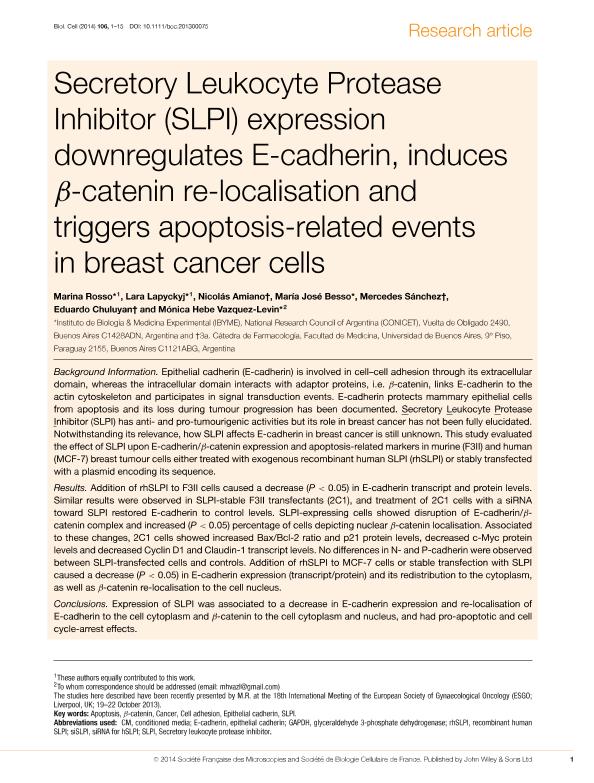Mostrar el registro sencillo del ítem
dc.contributor.author
Rosso, Marina

dc.contributor.author
Lapyckyj, Lara

dc.contributor.author
Amiano, Nicolás Oscar

dc.contributor.author
Besso, María José

dc.contributor.author
Sanchez, Mercedes Leonor

dc.contributor.author
Chuluyan, Hector Eduardo

dc.contributor.author
Vazquez, Monica Hebe

dc.date.available
2017-03-22T14:35:33Z
dc.date.issued
2014-09
dc.identifier.citation
Rosso, Marina; Lapyckyj, Lara; Amiano, Nicolás Oscar; Besso, María José; Sanchez, Mercedes Leonor; et al.; Secretory leukocyte protease inhibitor (slpi) expression downregulates E-cadherin, induces β-catenin re-localization and triggers apoptosis-related events in breast cancer cells; Wiley; Biology Of The Cell; 106; 9; 9-2014; 308-322
dc.identifier.issn
0248-4900
dc.identifier.uri
http://hdl.handle.net/11336/14168
dc.description.abstract
BACKGROUND INFORMATION: Epithelial cadherin (E-cadherin) is involved in cell–cell adhesion through its extracellular domain, whereas the intracellular domain interacts with adaptor proteins, i.e. β-catenin, links E-cadherin to the actin cytoskeleton and participates in signal transduction events. E-cadherin protects mammary epithelial cells from apoptosis and its loss during tumour progression has been documented. Secretory Leukocyte Protease Inhibitor (SLPI) has anti- and pro-tumourigenic activities but its role in breast cancer has not been fully elucidated. Notwithstanding its relevance, how SLPI affects E-cadherin in breast cancer is still unknown. This study evaluated the effect of SLPI upon E-cadherin/β-catenin expression and apoptosis-related markers in murine (F3II) and human (MCF-7) breast tumour cells either treated with exogenous recombinant human SLPI (rhSLPI) or stably transfected with a plasmid encoding its sequence. RESULTS: Addition of rhSLPI to F3II cells caused a decrease (P < 0.05) in E-cadherin transcript and protein levels. Similar results were observed in SLPI-stable F3II transfectants (2C1), and treatment of 2C1 cells with a siRNA toward SLPI restored E-cadherin to control levels. SLPI-expressing cells showed disruption of E-cadherin/β-catenin complex and increased (P < 0.05) percentage of cells depicting nuclear β-catenin localisation. Associated to these changes, 2C1 cells showed increased Bax/Bcl-2 ratio and p21 protein levels, decreased c-Myc protein levels and decreased Cyclin D1 and Claudin-1 transcript levels. No differences in N- and P-cadherin were observed between SLPI-transfected cells and controls. Addition of rhSLPI to MCF-7 cells or stable transfection with SLPI caused a decrease (P < 0.05) in E-cadherin expression (transcript/protein) and its redistribution to the cytoplasm, as well as β-catenin re-localisation to the cell nucleus. CONCLUSIONS: Expression of SLPI was associated to a decrease in E-cadherin expression and re-localisation of E-cadherin to the cell cytoplasm and β-catenin to the cell cytoplasm and nucleus, and had pro-apoptotic and cell cycle-arrest effects.
dc.format
application/pdf
dc.language.iso
eng
dc.publisher
Wiley

dc.rights
info:eu-repo/semantics/openAccess
dc.rights.uri
https://creativecommons.org/licenses/by-nc-sa/2.5/ar/
dc.subject
Apoptosis
dc.subject
Beta-Catenina
dc.subject
Cancer
dc.subject
Cell Adhesion
dc.subject
Ephitelial Cadherin
dc.subject
Slpi
dc.subject.classification
Bioquímica y Biología Molecular

dc.subject.classification
Ciencias Biológicas

dc.subject.classification
CIENCIAS NATURALES Y EXACTAS

dc.title
Secretory leukocyte protease inhibitor (slpi) expression downregulates E-cadherin, induces β-catenin re-localization and triggers apoptosis-related events in breast cancer cells
dc.type
info:eu-repo/semantics/article
dc.type
info:ar-repo/semantics/artículo
dc.type
info:eu-repo/semantics/publishedVersion
dc.date.updated
2017-03-06T18:06:40Z
dc.journal.volume
106
dc.journal.number
9
dc.journal.pagination
308-322
dc.journal.pais
Estados Unidos

dc.journal.ciudad
Hoboken
dc.description.fil
Fil: Rosso, Marina. Consejo Nacional de Investigaciones Científicas y Técnicas. Instituto de Biología y Medicina Experimental (i); Argentina
dc.description.fil
Fil: Lapyckyj, Lara. Consejo Nacional de Investigaciones Científicas y Técnicas. Instituto de Biología y Medicina Experimental (i); Argentina
dc.description.fil
Fil: Amiano, Nicolás Oscar. Consejo Nacional de Investigaciones Científicas y Técnicas. Instituto de Biología y Medicina Experimental (i); Argentina. Universidad de Buenos Aires. Facultad de Medicina. Cátedra de Farmacología; Argentina
dc.description.fil
Fil: Besso, María José. Consejo Nacional de Investigaciones Científicas y Técnicas. Instituto de Biología y Medicina Experimental (i); Argentina
dc.description.fil
Fil: Sanchez, Mercedes Leonor. Consejo Nacional de Investigaciones Científicas y Técnicas. Instituto de Biología y Medicina Experimental (i); Argentina. Universidad de Buenos Aires. Facultad de Medicina. Cátedra de Farmacología; Argentina
dc.description.fil
Fil: Chuluyan, Hector Eduardo. Consejo Nacional de Investigaciones Científicas y Técnicas. Instituto de Biología y Medicina Experimental (i); Argentina. Universidad de Buenos Aires. Facultad de Medicina. Cátedra de Farmacología; Argentina
dc.description.fil
Fil: Vazquez, Monica Hebe. Consejo Nacional de Investigaciones Científicas y Técnicas. Instituto de Biología y Medicina Experimental (i); Argentina
dc.journal.title
Biology Of The Cell

dc.relation.alternativeid
info:eu-repo/semantics/altIdentifier/url/http://onlinelibrary.wiley.com/doi/10.1111/boc.201300075/abstract
dc.relation.alternativeid
info:eu-repo/semantics/altIdentifier/doi/http://dx.doi.org/10.1111/boc.201300075
Archivos asociados
